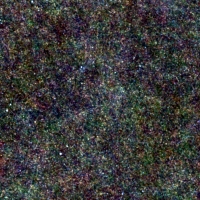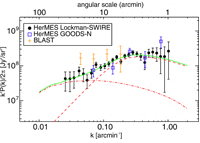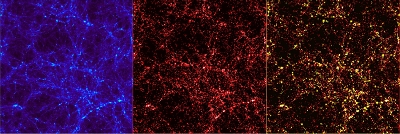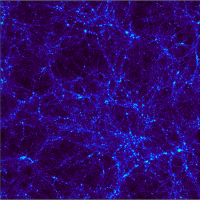Herschel quantifies the dark matter threshold for starburst galaxies
16 February 2011
How much dark matter is needed to trigger a starburst in the cosmic cribs where galaxies are born? A new study, based on data from ESA's Herschel Space Observatory, has revealed that dark matter halos with a mass larger than 300 billion times the Sun's are particularly efficient at igniting massive starbursts, as they house the most active star-forming galaxies in the Universe. Astronomers have discovered this key threshold by measuring small fluctuations in the Cosmic Infrared Background, the integrated diffuse emission produced by the dust from every galaxy that ever existed. These fluctuations trace the distribution of otherwise mostly unresolved star-forming galaxies and of the dark matter halos that enshroud them. These results are reported in the 24 February 2011 issue of Nature and are published online today.
 |
|
Herschel's deep infrared view of the Lockman Hole. |
Since the cosmic web constitutes the skeleton supporting the later emergence of stars and galaxies, the distribution of galaxies is expected to follow, and thus trace, that of the dark matter. Whereas the growth of dark matter structures is only regulated by gravity, a number of additional phenomena affect star and galaxy formation, resulting in two different clustering trends. Astronomers refer to this by saying that galaxies are biased tracers of the dark matter distribution.
An interesting feature in this context is that all galaxies are to be found within dark matter halos, with one or more galaxies inhabiting a halo, but not all halos are expected to harbour a galaxy. "The formation of a galaxy is simply not efficient enough in halos with masses that are either too large or too small," explains Asantha Cooray from the University of California, Irvine, USA, who directed the study based on Herschel data that has revealed new details about the most efficient sites for galaxy formation.
The study focussed on starburst galaxies, the most prolific stellar factories in the history of the Universe, which give birth to hundreds or even thousands of stars per year - as a comparison, our Galaxy produces, on average, only one star per year. It is during these intense bursts, lasting from tens to a few hundred million years, that certain types of galaxies are believed to acquire most of their stars. "Our analysis has led to the first observational estimate of the minimum mass of a halo in which a large number of stars could ignite suddenly, creating a starbursting galaxy. This is a key ingredient to improve our current understanding of galaxy formation and evolution," adds Cooray.
Extreme star-forming galaxies like these in the distant Universe have been a real puzzle for over a decade. They are rather challenging to detect individually, as source confusion effects arise because of the relatively poor angular resolution achievable at the wavelengths at which they radiate the bulk of their light. "As previous results obtained with early Herschel data show, even with deep observations it is possible to directly resolve only about 15 per cent of them," notes co-author Seb Oliver from the University of Sussex, United Kingdom, who coordinates the HerMES Key Programme together with Jamie Bock from Caltech, USA. "But this is not the end of the story: with the large maps of HerMES and the sensitivity and resolution of Herschel, we have finally been able to trace them," adds Oliver.
The infrared light radiated collectively by all faint, star-forming galaxies creates a diffuse background, known as the Cosmic Infrared Background (CIB). "The CIB exhibits fluctuations which closely reflect the clustering pattern of the galaxies responsible for it," says Alexandre Amblard from UC Irvine and currently at NASA Ames, first author of the Nature paper. Observing these fluctuations, which span a wide range of angular scales, is one of the very few methods available to explore the properties of the unresolved population of galaxies contributing to the CIB. "Thanks to Herschel's extraordinary data, we have been able, for the first time, to pin the fluctuations down to very small scales - about 1 arc minute," he adds.
 |
|
Clustering of faint, star-forming galaxies as a funtion of angular scale on the sky. |
In order to extract information about these galaxies and how they formed, the data need to be properly modelled. "The tool we employed for this is known as the halo model," says co-author Paolo Serra, also from UC Irvine and currently at NASA Ames. The halo model is a statistical approach to describe the dark matter distribution, which is viewed as an ensemble of discrete objects - the halos. Within this framework, galaxies and their clustering properties can be studied in relation to the dark matter halos to which they belong. "By applying the halo model to the fluctuations of the CIB measured by Herschel on both large and small scales, it was possible to characterise correlations in the distribution not only of galaxies that reside in different halos, but also of galaxies occupying the same halo," adds Serra.
The latter effect is the key to constraining differences in the way galaxies and dark matter halos tend to be grouped: it is, in fact, at the small scales that the two distributions deviate the most from each other, as the least massive amongst dark matter halos do not host galaxies. "This analysis has demonstrated that the starbursting galaxies we targeted tend to reside in halos with a mass greater than 3×1011 times that of the Sun, thus leading to a firm estimate of the minimum mass needed by a halo for a starburst galaxy to form within it," notes Amblard. "This value singles out the halos where star formation takes place at its highest efficiency, and is ten times lower than the one predicted by semi-analytical models for galaxy formation," adds Serra.
Theory suggests that star formation may set in even within dark matter halos with masses smaller than this value, but it is expected to be promptly suppressed by supernova explosions of the most massive amongst these first stars: these would blow away the surrounding gas which, in the absence of the strong gravitational potential of a massive dark matter halo, would leave the halo barren. At the other end of the scale, if the dark matter halo is too massive, the cooling of gas is inefficient and cannot happen rapidly enough to produce a starburst.
"From a theoretical perspective, the interplay between these two mechanisms, and possibly with other processes as well, is not yet fully understood," notes Cooray. "In this context, our measurements provide strong evidence for a mass scale where these effects are balanced, resulting in a very powerful star formation activity. This value will now have to be taken into account by all theoretical efforts trying to model the properties of starbursting galaxies, and will certainly shed new light on some still nebulous details about galaxy formation," concludes Cooray.
Notes for editors
The study relies on data from the Herschel Multi-tiered Extra-galactic Survey (HerMES), a Guaranteed Time Key Programme probing galaxy evolution at high redshift. The observations have been performed with the SPIRE instrument aboard Herschel during the Science Demonstration Phase at the end of 2009. The data consist of a wide area in the Lockman Hole, measuring 218 × 218 square arc minutes, complemented by a narrow and deep map of the GOODS North field, covering 30 × 30 square arc minutes, which have been observed at wavelengths of 250, 350 and 500 μm.
Herschel is an ESA space observatory with science instruments provided by European-led Principal Investigator consortia and with important participation from NASA. The SPIRE instrument contains an imaging photometer (camera) and an imaging spectrometer. The camera operates in three wavelength bands centred on 250, 350 and 500 μm, and so can make images of the sky simultaneously in three sub-millimetre colours. SPIRE was designed and built by an international collaboration, led by Professor Matt Griffin of Cardiff University, UK.
HerMES is the largest Herschel Key Programme in terms of observing time and aims at studying the evolution of galaxies in the distant Universe. The project is carried out by a large international collaboration, including many institutes from across the world, and in particular the team who built the SPIRE instrument on board Herschel.
Related publications
Amblard, A., Cooray, A., Serra, P., et al., "Sub-millimetre galaxies reside in dark matter halos with masses greater than 3×1011 MSun", Nature, DOI: 10.1038/nature09771
Cooray, A., & Sheth, R., "Halo Models of Large Scale Structure", Physics Reports, Vol 372, pp. 1-129, 2002
DOI: 10.1016/S0370-1573(02)00276-4
Contacts
Alexandre Amblard
University of California, Irvine
and NASA Ames Research Center
USA
Email: alexandre.amblard nasa.gov
nasa.gov
Phone: +1-415-294-1882
Asantha Cooray
University of California, Irvine
USA
Email: acooray uci.edu
uci.edu
Phone: +1-949 824-6832
Paolo Serra
University of California, Irvine
and NASA Ames Research Center
USA
Email: paolo.serra nasa.gov
nasa.gov
Phone: +1-714-463-8249
Seb Oliver
Principal Investigator of the HerMES Key Programme
University of Sussex, United Kingdom
Email: S.Oliver sussex.ac.uk
sussex.ac.uk
Phone: +44-1273-678852
Göran Pilbratt
Herschel Project Scientist
Research and Scientific Support Department
Science and Robotic Exploration Directorate
ESA, The Netherlands
Email: gpilbratt rssd.esa.int
rssd.esa.int
Phone: +31 71 565 3621



